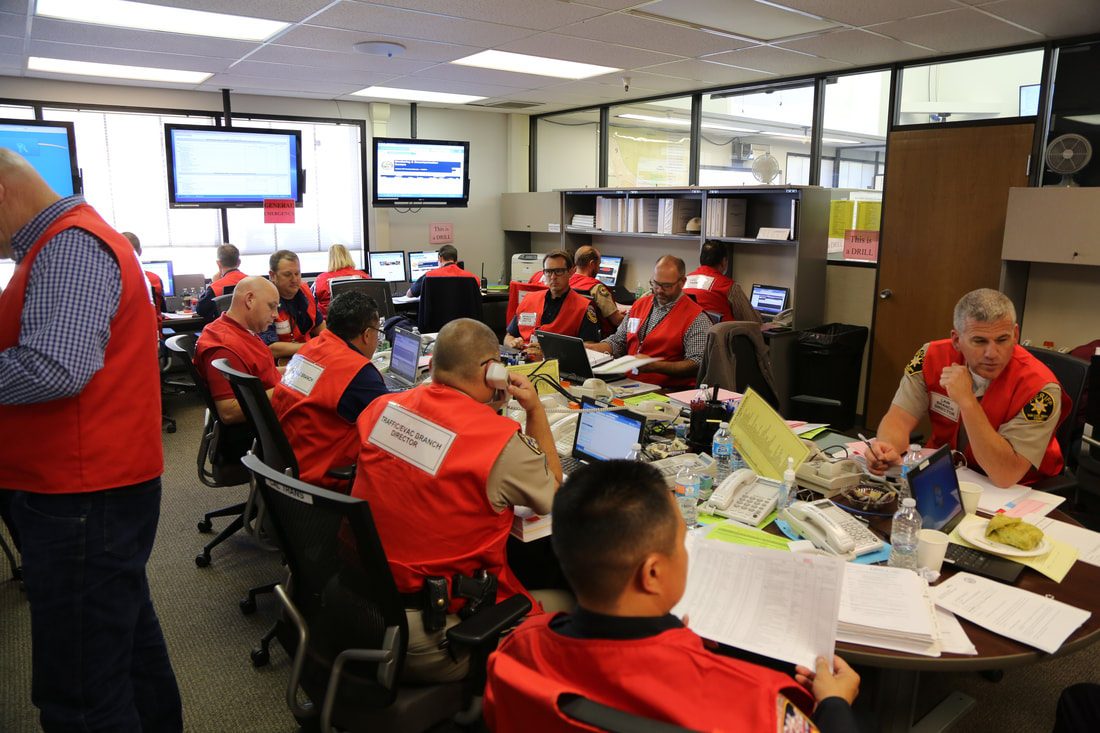Operating Efficiently During 2017 Emergencies

While the County responds to thousands of emergencies every year through various departments, it only activates its Emergency Operations Center when needed. This center, located between San Luis Obispo and Morro Bay, acts as a centralized location to mobilize and coordinate a multi-agency response to emergencies. The decision to activate the Emergency Operations Center is typically made when responding agencies need additional resources and support.
The summer of 2017 was a particularly active time for the County’s Emergency Operations Center and the County Office of Emergency Services (OES). While most emergencies can be handled from the field, the County activated its Emergency Operations Center three times in the summer months last year.
The Hill Fire
In June 2017, the Hill Fire broke out near Santa Margarita, ultimately burning 1,598 acres and destroying four homes. The Emergency Operations Center was initially activated to help notify the public about evacuation orders. Staff at the Emergency Operations Center sent out three Wireless Emergency Alerts system messages (which send a text message to all cell phones in a certain area) and posted important information on social media to inform affected residents and the public of the orders. Additionally, Emergency Operations Center staff coordinated with the American Red Cross to open a shelter at Santa Margarita Elementary School for evacuated residents and worked with the Animal Services Division of the County Health Agency to provide supplies for animals at that shelter.
The Stone Fire
Just one month later, in July 2017, the Stone Fire broke out east of Santa Margarita, ultimately burning 340 acres and destroying seven structures. County Fire initially requested that County OES activate the Emergency Operations Center in support of their efforts. Staff members at the Emergency Operations Center were again able to provide evacuation and road closure information to the public, including sending one message via the Wireless Emergency Alert System. Staff at the Emergency Operations Center again helped coordinate an American Red Cross shelter at Santa Margarita Elementary School.
The Alert at Diablo Canyon
Later that same month, in July 2017, Diablo Canyon Power Plant declared an Alert, which is the Nuclear Regulatory Commission’s second least severe emergency classification of off-normal events at nuclear power plants. An Alert is the second least severe and indicates possible damage of a plant safety system. In this case, it was based on slightly decreased oxygen levels in the nuclear reactor’s containment building. As soon as the County received the Alert notification from PG&E, the County Sheriff’s Watch Commander and County OES teams began mobilizing a response. Various agencies quickly responded to the Emergency Operations Center to monitor the situation and provide information to the public. Ultimately, no one was hurt, there was no risk to the public, and the plant remained operating safely at full power.
Planning and Preparation for Any Coordinated Emergency Response
The County OES team works hard to ensure that the Emergency Operations Center is kept in a constant state of readiness for effective response operations, should it be required. This includes testing all equipment monthly, ensuring plans and procedures are kept up to date and available for use within the EOC, providing training to staff to qualify them for the positions they fill, and holding exercises to practice for an actual response. OES continues to strive to make the County Emergency Operations Center even more responsive by incorporating new technology and services operations.
The County learns from each training, exercise, and emergency response, as well as lessons learned from other jurisdictions who have faced large incidents. This allows the County to better prepare for the next disaster.
For more information on emergencies and emergency preparedness, visit the OES website.
The summer of 2017 was a particularly active time for the County’s Emergency Operations Center and the County Office of Emergency Services (OES). While most emergencies can be handled from the field, the County activated its Emergency Operations Center three times in the summer months last year.
The Hill Fire
In June 2017, the Hill Fire broke out near Santa Margarita, ultimately burning 1,598 acres and destroying four homes. The Emergency Operations Center was initially activated to help notify the public about evacuation orders. Staff at the Emergency Operations Center sent out three Wireless Emergency Alerts system messages (which send a text message to all cell phones in a certain area) and posted important information on social media to inform affected residents and the public of the orders. Additionally, Emergency Operations Center staff coordinated with the American Red Cross to open a shelter at Santa Margarita Elementary School for evacuated residents and worked with the Animal Services Division of the County Health Agency to provide supplies for animals at that shelter.
The Stone Fire
Just one month later, in July 2017, the Stone Fire broke out east of Santa Margarita, ultimately burning 340 acres and destroying seven structures. County Fire initially requested that County OES activate the Emergency Operations Center in support of their efforts. Staff members at the Emergency Operations Center were again able to provide evacuation and road closure information to the public, including sending one message via the Wireless Emergency Alert System. Staff at the Emergency Operations Center again helped coordinate an American Red Cross shelter at Santa Margarita Elementary School.
The Alert at Diablo Canyon
Later that same month, in July 2017, Diablo Canyon Power Plant declared an Alert, which is the Nuclear Regulatory Commission’s second least severe emergency classification of off-normal events at nuclear power plants. An Alert is the second least severe and indicates possible damage of a plant safety system. In this case, it was based on slightly decreased oxygen levels in the nuclear reactor’s containment building. As soon as the County received the Alert notification from PG&E, the County Sheriff’s Watch Commander and County OES teams began mobilizing a response. Various agencies quickly responded to the Emergency Operations Center to monitor the situation and provide information to the public. Ultimately, no one was hurt, there was no risk to the public, and the plant remained operating safely at full power.
Planning and Preparation for Any Coordinated Emergency Response
The County OES team works hard to ensure that the Emergency Operations Center is kept in a constant state of readiness for effective response operations, should it be required. This includes testing all equipment monthly, ensuring plans and procedures are kept up to date and available for use within the EOC, providing training to staff to qualify them for the positions they fill, and holding exercises to practice for an actual response. OES continues to strive to make the County Emergency Operations Center even more responsive by incorporating new technology and services operations.
The County learns from each training, exercise, and emergency response, as well as lessons learned from other jurisdictions who have faced large incidents. This allows the County to better prepare for the next disaster.
For more information on emergencies and emergency preparedness, visit the OES website.

